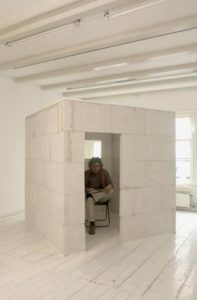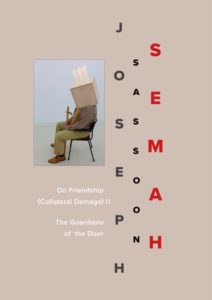On Friendship / (Collateral Damage) II – The Guardians of the Door ~ Summary

Joseph Semah – MaKOM The doubling of the House 1979 – 2017 cellenbetonblokken 200 x 200 x 200 cm Photo: Ilya Rabinovich
Artist Joseph Sassoon Semah (1948) was born in Bagdad, where his grandfather Hacham Sassoon Kadoori (1885-1971) was Chief Rabbi of the Babylonian Jews. In 1950 he was ‘relocated’ with his parents to the State of Israel. In the mid-70’s Semah decided to leave Israel, speaking in this context of his self-chosen exile. He lived and worked in London, Berlin and Paris; but has been settled in Amsterdam since 1981, where he has positioned himself as ‘the Guest’. By reading in his native language, Hebrew, he has detected a shortage of Jewish awareness. Jewish significance receives too little attention in western history of art and Semah feels the urgent need to append this and to fill the ’empty page’.
During his long-term project On Friendship / (Collateral Damage) in which he collaborates with Metropool International Art Projects / Studio Meritis MaKOM (Linda Bouws), the main question is how western art and culture are presented and why. In Part 1 (2015) Semah searches for the specific Jewish implications in Kazimir Malevich’s The Black Square and Barnett Newman’s work, and also critically researches the claim by a growing group of people that refer to the Jewish-Christian origin of European culture.
Through his lawyer Bob Vink, Semah makes contact with Beatrix Ruf, director of the Stedelijk Museum Amsterdam and asks her to account for the ’empty page’ in art history on behalf of the art world.
In On Friendship / (Collateral Damage) II – The Guardians of the Door, Luther and 500 years of Reformation are the central subject: with art, performances, artistic interventions, round-table conversations, lectures and a book publication. There will be critical reflection on the image of Luther as a ‘superstar’ and on his importance then and now. The Nieuwe Kerk, The Joods Historisch Museum, the Stedelijk Museum and the Goethe-Institut are all partners in this project.
The starting point was Semah nailing his answer to Luther on the door of the Nieuwe Kerk, preceded by a ‘procession’ coming from the Dam square.
The Answer is this:
And in the background we still see the unsolvable dilemma of the Guest. On the one hand he is forced to be silent about his highly personal way of reading, while on the oter hand he uses Christian tactics to be noticed without being discovered.
The Guest in ourselves is primarily an artist with words, for words form the way he has learned to conceal his name, hide his doubt and suppress his fear by publicly criticising his wish to participate within the western paradigm. Please note, the nostalgia for a lost paradise, will pursue the Guest from the start and during his whole active life in exile.
Signed by JOSEPH SASSOON SEMAH
JOSEPH SASSOON SEMAH
After this intervention at the church-door there was a round-table conversation about Luther’s influence on the arts. From every angle that one looks at Luther’s influence, we must acknowledge the background of the speakers: christianity, judaism and art world.
Irene Zwiep, professor of Hebrew and Jewish studies at the University of Amsterdam, entered the discussion on the influence Luther’s Reformation had had on Judaism.
“The basic thought is that ‘a’ Judaism does not exist. It has by definition always been a many-voiced matter, within which dissidents could voice their different opinions. For that reason a reformation, meaning a radical restructuring, was unnecessary. ‘Chiddush’ (renewal) was for centuries synonymous to ‘massoret’ (tradition). Until, according to Zwiep, in 1820 a group of young Jews from Berlin decided to implement Luther’s Reformation nonetheless. Because of their interference ‘massoret’ became history and ‘chiddus’ judaism.
On the 13th of July 2017, Joseph Semah pursued the case with a public intervention/installation in the Nieuwe Kerk, observed by a large audience. At the end of the performance the audience is invited to fasten the 5000 meter of long threads to the table. They are finally pinned down with a boiled egg (95 in all, in reference to Luther’s 95 theses), leaving a fan shape of threads on the church floor.
In the Joods Historisch Museum there will be a a special selection of Semah’s work on show, from the 5th of October 2017 until the 7th of January 2018. An exhibition directly reflecting upon On Friendship / (Collateral Damage) II – The Guardians of the Door.
On the 20th, 21st and 22nd of October the conversation continued with the Stedelijk Museum Amsterdam, including a round-table session, the presentation of the book publication On Friendship / (Collateral Damage) II – The Guardians of the Door, five unique performances by Joseph Semah and a three-day reading session in a specially constructed MaKOM house made of concrete blocks set at the entrance, in which Semah will read from selected texts of his 30-year research into the ’empty page’.
This way the Stedelijk Museum agrees to the question of our times that a museum must be more than just a place of presentation, but also a place where different interpretations and visions on art can be fully appreciated.
Visions formulated in the book by Egbert Dommering, Maarten Doorman, Arie Hartog, Paul Mosterd, Margriet Schavemaker, Emile Schrijver, Rick
Vercauteren, Felix Villanueva en Jan Voss, and including texts by Joseph Semah en Linda Bouws.
At the Goethe-Institut (9th of November) there will be a meeting with Arie Hartog, director of the Gerhard-Marcks Haus in Bremen and five pieces of art by Semah will be exhibited.
We thank everyone who has collaborated on On Friendship / (Collateral Damage) II – The Guardians of the Door, and made it possible for us to realize this project.
 Publicatie
Publicatie
Linda Bouws & Joseph Semah (red.) – On Friendship / (Collateral Damage) II – The Guardians of the Door
Reflectie vanuit de kunst en cultuur op 500 jaar reformatie en Maarten Luther, met en rond Joseph Sassoon Semah.
Auteurs:
Joseph Semah – Pretext en The Guardians of the Door: how to explain hare hunting to a dead German artist
Emile Schrijver – Flarden van associaties: een soort brief aan een vriend
Arie Hartog – Over het onderzoek van Joseph Semah: begrijpen wie aan tafel zit
Paul Mosterd – In situ: kunstenaar en kerk
Linda Bouws – Wanneer kunst religie raakt
Egbert Dommering – Luther, Reuchlin en Joseph Semah
Jan Voss – “That’s too bad even for an ice cream parlour”
Maarten Doorman Luther als open zenuw van de Duitse geschiedenis
Felix Villanueva – Todnauberg (Re)Visited. Over de ontmoeting tussen de dichter en denker
Rick Vercauteren – Next Year in Jerusalem
Margriet Schavemaker – Dwingende voetnoten: Joseph Semah en het Stedelijk Museum<
Te bestellen via: Stichting Metropool Internationale Kunstprojecten, 35 € + 5 € verzendkosten, rek.nr. INGB 0006928168 o.v.v. “On Friendship”, naam en adres